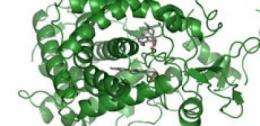Best drug development results from computer/test tube combination

While computer simulations of how the body metabolises drugs save both time and money, the best results when developing new drugs come from combining such simulations with laboratory experiments, reveals a researcher from the University of Gothenburg.
"My research demonstrates the benefits of combining traditional laboratory experiments with computer-based calculation models to understand and explain how the body's various enzymes interact with a drug when breaking it down," says Britta Bonn from the University of Gothenburg's Department of Chemistry. "It can really help when developing and designing molecules with the desired metabolic characteristics for a new drug."
When developing new drugs, it is important to understand how they will be broken down in the body, and which products are formed during this process. This breakdown of foreign substances is known as metabolism, and can be viewed as the conversion of the drug to a non-toxic, water-soluble product that can easily leave the body, in urine for example.
Enzymes does the job
Drug metabolism is the work of catalysts known as enzymes, and generally takes place in the liver. If a drug is broken down too effectively, it may not have the desired effect, and toxic metabolic products may form. It is therefore important to study and understand how drugs are broken down.
Traditionally laboratory experiments have been used to study drug/enzyme interactions, for example in cell-based systems in test tubes (in vitro). Recent years have also brought major progress in computer-based models (in silico) and information on the enzymes' 3D structures.
Combines in vitro and in silico
Britta Bonn has focused on two important enzymes from the CYP family, which are the most common drug-metabolising enzymes, both in vitro and in silico to understand how they interact with foreign substances.
"My studies aimed to find out things like how well a molecule binds to the enzymes, why a molecule binds better to one enzyme than another, and how quickly and where in the molecule metabolism occurs," says Bonn. "If we know more, we can change the molecules to produce the haracteristics we're after for new drugs."
Provided by University of Gothenburg















